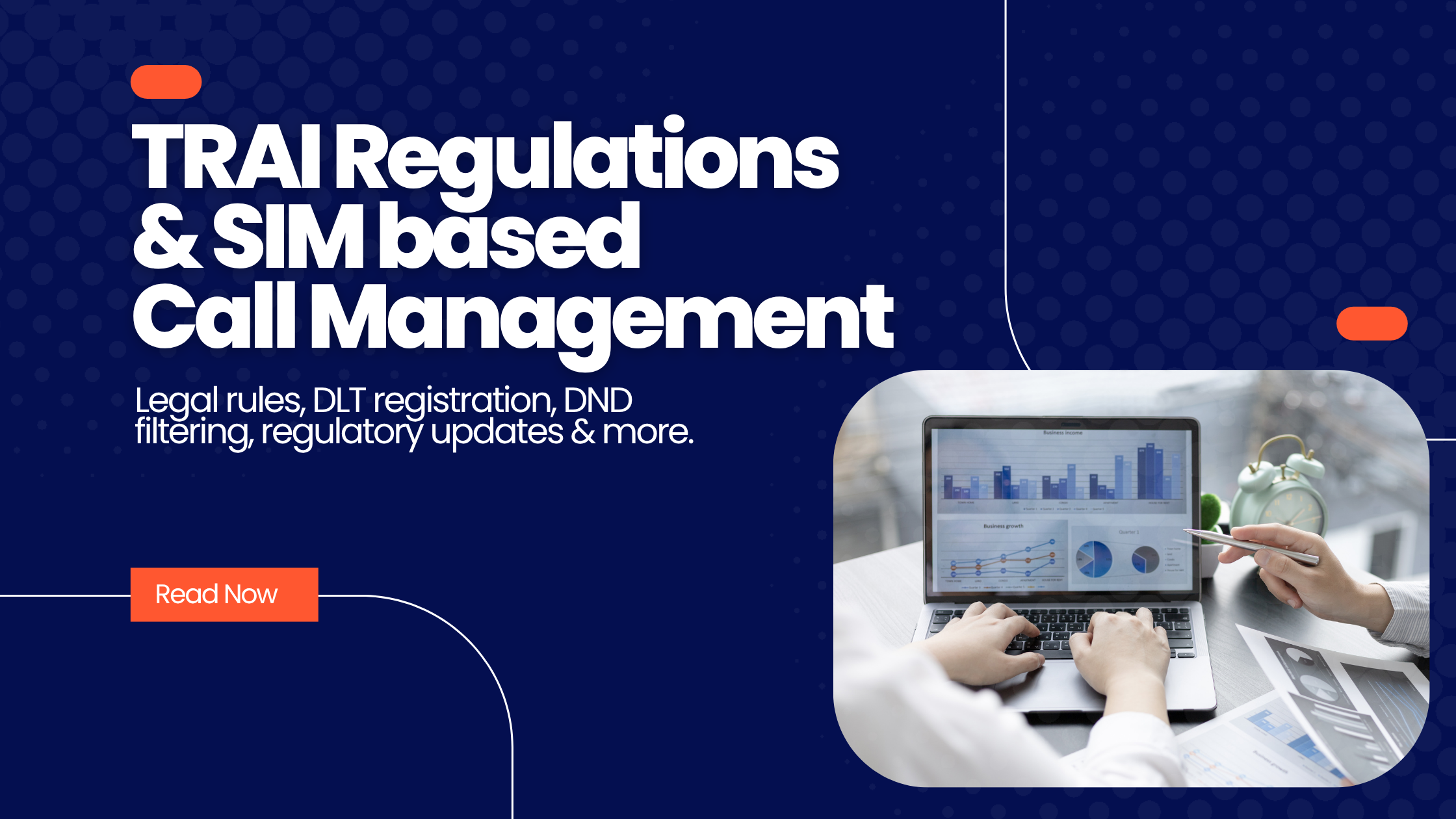In the rapidly evolving landscape of outbound sales, service, and customer engagement, SIM-based call management remains a preferred choice for many Indian businesses.
As new regulations batch in for 2025 and fresh updates are expected for 2026, understanding Telecom Regulatory Authority of India (TRAI) compliance is not just important; it’s essential to avoid penalties, maintain credibility, and build trusted customer relationships.
This comprehensive guide will answer key questions on how SIM-based calling fits within TRAI norms, step-by-step registration, number management, consent, DND filtering, and future regulatory outlook.
What is SIM-Based Call Management and Is It Allowed by TRAI?
SIM-based call management refers to the use of physical SIM cards in devices to make large volumes of outbound calls, either manually or via dialing software. Unlike cloud telephony using virtual numbers, SIM-based calling relies on mobile network operator infrastructure. The critical question remains: “Is SIM-based outbound calling compliant with TRAI in 2025?”
Yes, SIM-based call management is compliant, provided every regulatory requirement prescribed by TRAI is met, including telemarketer registration, DLT platform use, and DND consent management.

TRAI Regulatory Framework for Outbound Calling
TRAI regulates commercial communications under the Telecom Commercial Communications Customer Preference Regulations (TCCCPR), 2018, which continue to evolve. The latest updates focus on stricter traceability, more transparent consent mechanisms, and unified numbering rules.
Key Elements of TRAI Regulations:
- Every business sending promo calls or messages must register as a telemarketer with TRAI through their approved telecom operator.
- Businesses must use Distributed Ledger Technology (DLT) platforms to log, monitor, and audit all commercial communications.
- Numbering rules mandate use of specific series (e.g., 140-series for promotions, 160-series for financial services), particularly for sector-specific use cases such as stockbroking and banking.
- Calls to numbers on the National Do Not Disturb (DND) list, or without consent, are strictly prohibited.

How Do You Register with TRAI for SIM-Based Calling?
A commonly asked query: “How can I register to make outbound sales calls using SIMs?” The registration process is uniform whether using SIM or virtual numbers.
Step-by-Step Telemarketer Registration:
- Choose a telecom operator offering DLT platform access. Submit your business proof, PAN, and authorized representative details.
- Register your sender IDs, templates, and upload your list of intended contacts, ensuring each has proper consent.
- Set up DND API access or use DLT built-in scrubbing features to filter out numbers listed in the National DND registry.
- Await telemarketer approval. On completion, you gain access to SMS/call templates, reporting, and compliance dashboards.

What Is DLT and Why Do You Need It?
DLT platforms (Distributed Ledger Technology) are the backbone of current and upcoming compliance frameworks. They help businesses answer key questions like:
- “How do I ensure my SIM-based calls don’t break TRAI rules?”
- “What audit trail does TRAI require for outbound calls?”
All commercial outbound calls and messages, SIM or virtual; must be registered and logged on a DLT portal. DLT provides full traceability, making it easier for businesses to verify compliance, for regulators to audit flow, and for customers to report issues.
Consent & DND Compliance: Best Practice Essentials
User queries often revolve around DND and consent: “How not to call DND numbers?”, “How to collect consent for sales calls?” Consent is the foundation of legal outbound calling. Before dialing a number, businesses must:
- Secure explicit, documented consent for marketing or promotional campaigns, preferably digital and timestamped.
- Scrub all call lists for numbers present in the National DND registry using real-time APIs or DLT batch tools.
- Retain consent records for audits and customer complaints.
TRAI may soon mandate real-time consent traceability using DLT enhancements for 2026, making digital consent even more critical.
To conduct effective DND scrubbing and remain fully compliant with TRAI’s outbound calling regulations, businesses must follow precise steps using official tools and processes. Here’s how to do DND scrubbing for SIM-based and virtual number campaigns in India, complete with authentic government links for each step.
Steps to Do DND Scrubbing in India
1. Register Your Business on a TRAI-Approved DLT Platform
Begin by registering as a telemarketer with a telecom operator that provides access to TRAI’s Distributed Ledger Technology (DLT) platform. Upload necessary documents—business proof, PAN, and authorized person details.
2. Collect and Organize Your Contact List
Prepare the list of mobile numbers intended for outbound calls. Ensure each entry is in the correct format (usually Excel or CSV) and maintains required consent records.
3. Access a DND Database or API
Use your DLT platform’s integrated DND filtering feature or visit the official Sanchar Saathi Portal for information and API options. Some DLT platforms enable batch list uploads; others offer real-time API endpoints.
4. Upload Your Contact List for Scrubbing
Submit your contact list for DND checking—this can be done either through an API integration (for automated filtering) or by uploading a file to your operator’s DLT portal. The system checks each number against the National Customer Preference Registry (NCPR).
5. Download the Scrubbed List
Once the DND scrub is complete, download the filtered output. Marked DND numbers will be flagged, and you must remove these from your campaign list.
6. Store DND Scrubbing Reports for Compliance
Maintain a record of each DND scrub, including timestamps and output files. These records may be requested for future audits or customer complaint investigations.
7. Finalize Your Campaign List
Proceed to use only those numbers which pass the DND filters for your outbound calling campaigns.
8. Repeat Scrubbing Before Every Campaign
Perform DND scrubbing regularly, ideally before every campaign or call batch, as customers may register for DND at any time.

SIM Numbers vs Virtual Numbers: Regulatory Perspective
One of the top questions is, “How does TRAI view SIM-based numbers compared to virtual numbers?” For commercial compliance, TRAI does not differentiate between SIM and virtual numbers. Both must adhere to the same registration and consent protocols, with the exception of mandated numbering series for specific verticals.
However, SIM numbers typically experience a longer window before being marked as spam, making them attractive for outbound calling, provided businesses comply with regulations.
Audit Trail & Traceability – TRAI Mandates
“Do you need to log every SIM-based call as a business?” Yes. TRAI expects businesses to maintain detailed logs of all calls and messages initiated for commercial purposes. Reporting tools available on DLT platforms are designed to help businesses:
- Track when and to whom calls are made.
- Prove that DND scrubbing was conducted.
- Demonstrate proper consent collection.
What Are the Risks of Non-Compliance?
Frequently searched: “What penalties apply for violating TRAI outbound calling rules?” Non-compliance can result in penalties ranging from warnings and fines to complete blacklisting and connection suspension.
Looking Ahead: Upcoming 2026 TRAI Reforms
- Expect tighter real-time consent requirements, integration with national ID for enhanced traceability, and stricter DND enforcement.
- New rules may require businesses to actively notify users on every promotional call and provide instant opt-outs.
Actionable Tips for Businesses Using SIM-Based Call Management
- Always register with TRAI and telecom operator as a commercial caller.
- Use DLT platforms to maintain compliance and traceability.
- Scrub lists regularly for DND status and log every consent.
- Use sector-appropriate numbering (140, 160 series) for stockbrokers, banks, and regulated verticals.
- Monitor compliance updates from TRAI (check trai.gov.in for amendments and notifications).

Frequently Asked Questions
1. Is SIM-based outbound calling legal for sales and marketing in India?
Yes, provided all TRAI requirements for telemarketer registration, DLT logging, and consent management are followed.
2. How do I register a SIM-based calling business with TRAI?
Through telecom operators offering DLT access; submit business documents, register templates, and set up DND scrubbing.
3. What is the difference between calling from a SIM and a virtual number under TRAI?
Both are treated equally for compliance. Exceptions apply in certain regulated industries where specific numbering is required.
4. What are the penalties for non-compliance in SIM-based calling?
Penalties include call suspension, fines, and permanent blacklisting for repeated offenses.
5. How often should businesses scrub contacts for DND compliance?
Ideally in real time, or at least before every campaign. Many DLT platforms provide API or batch features for easy compliance.
6. Will TRAI regulations change in 2026?
Yes, more robust DLT integration, consent requirements, and traceability will roll out. Regularly check for TRAI updates online.


